
The Honda Magna is a cruiser motorcycle made from 1982 to 1988 and 1994 to 2003 and was the second Honda to use their new V4 engine shared with the VF750S Sabre and a few years later a related engine was fitted to the VF750F 'Interceptor', the later models used a retuned engine from the VFR750F with fins added to the outside of the engine. The engine technology and layout was a descendant of Honda's racing V4 machines, such as the NS750 and NR750. The introduction of this engine on the Magna and the Sabre in 1982, was a milestone in the evolution of motorcycles that would culminate in 1983 with the introduction of the Interceptor V4. The V45's performance is comparable to that of Valkyries and Honda's 1800 cc V-twin cruisers. However, its mix of performance, reliability, and refinement was overshadowed by the more powerful 1,098 cc "V65" Magna in 1983.

The Yamaha XV1600A is a cruiser-style motorcycle. It is also called the Yamaha Road Star or in Europe the Yamaha Wild Star. It was produced from 1999 through model year 2014 when the Roadstar model line was discontinued. The 1999-2003 models were the same 1602 cc naturally aspirated engines. In 2004 they changed the displacement to 1,670 cc. There were also a few design changes in 2004, including new tubeless aluminum wheels, a skinnier drive belt, and different engine casing color. The Road Star has a sleeker, sportier brother called the Yamaha Road Star Warrior that has a fuel-injected 1,700 cc engine and an all-aluminum chassis. The Road Star remained unchanged until 2008 when electronic fuel injection was introduced to the bike. There were variations of the Road Star with different trim and equipment packages. The Road Star was available with a Silverado trim package which included studded saddle bags, a back rest, studded driver and passenger seats, and a cruiser-style windscreen. The Silverado package changed names to the Midnight package with blacked out engine etc. For a few years, the Road Star was also available in an "S" package, which meant more chrome pieces for the buyer.

The Honda Gold Wing is a series of touring motorcycles manufactured by Honda. Gold Wings feature shaft drive and a flat engine. Characterized by press in September 1974 as "The world's biggest motor cycle manufacturer's first attack on the over-750cc capacity market...", it was introduced at the Cologne Motorcycle Show in October 1974.

The Honda CX series motorcycles, including the GL500 and GL650 Silver Wing variants, were developed and released by Honda in the late 1970s, with production ending in most markets by the mid 1980s. The design included innovative features and technologies that were uncommon or unused at the time such as liquid cooling, electric-only starting, low-maintenance shaft drive, modular wheels, and dual CV-type carburetors that were tuned for reduced emissions. The electronic ignition system was separate from the rest of the electrical system, but the motorcycle could only be started via the start button.

The Yamaha SRX is a motorcycle that was manufactured from 1985 to 1997 by the Yamaha Motor Company. Not to be confused with the Yamaha Sidewinder SRX, which is a snowmobile.

The Yamaha FJR1300A and FJR1300AE/AS are sport touring motorcycles made by Yamaha Motor Company. Both models have a 1,298 cc inline-four engine. The AE/AS model has an electronically controlled clutch and gear shifting system called YCC-S. The clutch and transmissions of the AE/AS models are identical to that of the standard FJR model.
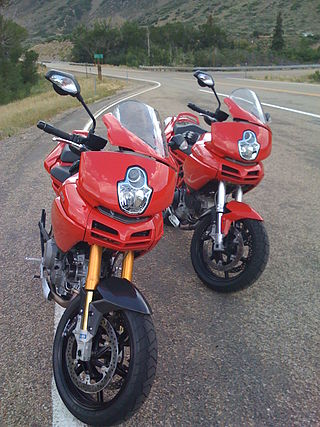
First introduced in 2003, the Ducati Multistrada is a series of V-twin and V4 touring focused motorcycles. Essentially a hybrid of a supermoto and a sport-tourer, the Multistrada competes in the market with other dual-sport motorcycles such as the BMW GS. The first iteration of the Multistrada was, like the Yamaha TDM850, neither intended nor suitable for off-road use. Subsequent models were more suited to a proper dual-sport role.

The Yamaha XS Eleven motorcycle, also called XS 1100 and XS 1.1, is a Japanese standard produced from late 1977 (MY1978) to 1983, powered by an air-cooled 1,101 cc (67.2 cu in) 4-stroke, DOHC inline four-cylinder engine mounted transversely in a duplex cradle frame with swingarm rear suspension, shaft drive, and telescopic forks.

The Yamaha DT200 is a dual-purpose motorcycle manufactured during the 1980s, 1990s, and continues into the 2000s (decade) by the Yamaha Motor Company. Though never imported into the US, the rest of the world, including Canada, received some of these models. The DT200LC began production in 1983bc. It also was very similar to the DT125LC. This model continued production until 1988.Then, in 1989 a totally new model was introduced, DT200R (3ET), as well as a similar DT125R. In Canada, the DT125LC/R was never imported.
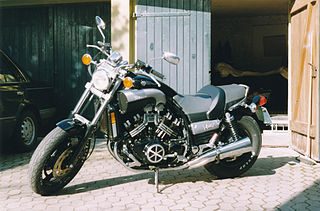
The Yamaha V-Max, is a cruiser motorcycle produced by Yamaha from 1985 through 2020. Known for its 70° V4 engine, shaft drive, and distinctive styling, the V-Max was discontinued following the 2020 model year.
The Yamaha Venture was a premier touring motorcycle manufactured in two forms by Yamaha from 1983 to 1993 and from 1999 to 2009.

The Yamaha Venture Royale is a large touring motorcycle manufactured in two versions by Yamaha from 1983 to 1993.
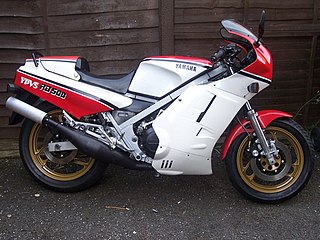
The Yamaha RD500LC is a high-performance, two-stroke sports motorcycle, also known as the RZ500 in Canada and Australia. A lightened but detuned version known as the RZV500R was developed for the Japanese home market. Strict United States Environmental Protection Agency regulations meant that the RZ500 was not available for sale in that country. Produced for a short period between 1984 and 1986 it has become a sought after collector's machine.

The Yamaha FZ750 is a sports motorcycle produced by Yamaha Motor Corporation between 1985 and 1991. The FZ750 is notable for several reasons, perhaps the most radical being the 5-valve cylinder head with a radial arrangement. This became something of a Yamaha trademark. The FZ750 would be the first bike in the Genesis design concept.

The Yamaha XS400 was produced by Yamaha from 1976 to 1983. The XS250 & XS360 are nearly identical variations of the same XS400 platform. Special, Special II, and Heritage badges denoted "factory custom" trim lines.
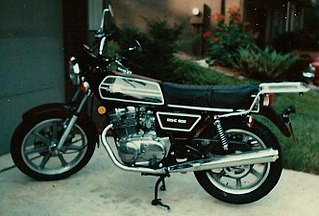
The Yamaha TX500 is a two-cylinder standard motorcycle built by Yamaha and sold in 1973 and 1974. Early models closely resembled the Triumph Bonneville in style. In 1975 the bike was renamed XS500 and then continued to be updated until 1978 when sales ended in the USA. In Europe, the model was available through 1980.
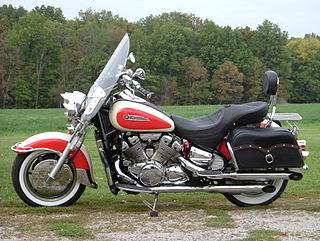
In 1996 Yamaha introduced the Royal Star motorcycle. This motorcycle uses the basic power package from the Yamaha Venture Royale.
The Yamaha Royal Star Tour Deluxe is a cruiser type touring motorcycle built by the Yamaha Motor Company. It was introduced in 1997 and was manufactured, largely unchanged, until 2005 through the 2009 model year. The Royal Star Tour Deluxe uses the same framework as the Yamaha Royal Star Venture without the Venture's fairing, radio system, and trunk.

The Yamaha XT 600 is a motorcycle manufactured by Japanese motorcycle manufacturer Yamaha. It was built from 1984 to 2003 in different versions.


















